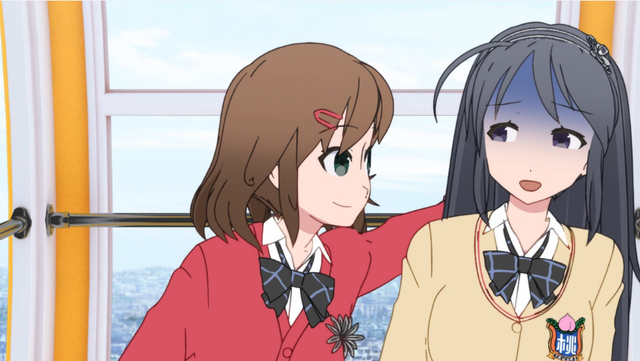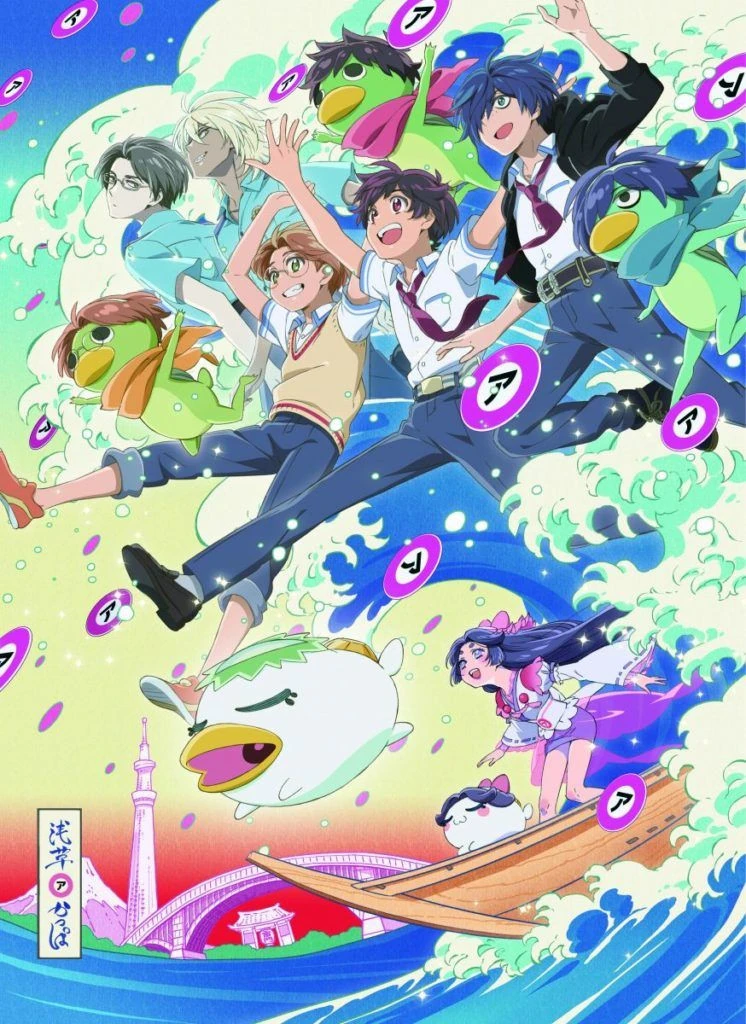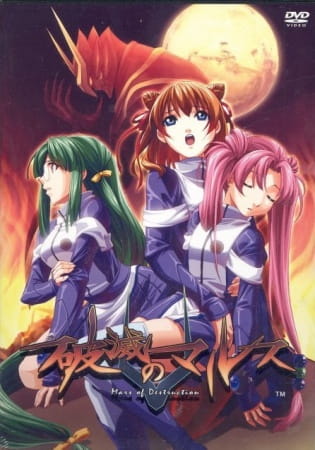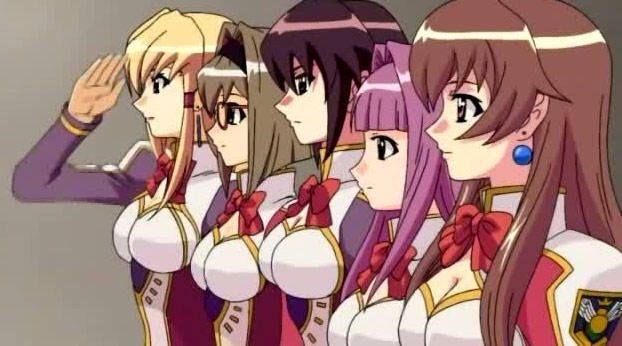 |
| From https://static.tvtropes.org/pmwiki/pub/ images/Gravion_1126.jpg |
Director: Masami Ōbari
Screenplay: Fumihiko Shimo
Voice Cast: Haruna Ikezawa as
Runa Gusuku; Houko Kuwashima as Leele; Jun Fukuyama as Toga Tenkuji; Kenichi
Suzumura as Eiji Shigure; Mai Nakahara as Eina; Yuu Asakawa as Mizuki
Tachibana; Hikaru Midorikawa as Raven; Sho Hayami as Klein Sandman
Viewed in Japanese with English Subtitles
The giant robot/super robot anime
was 1963's Tetsujin-28, an
adaptation of Mitsuteru Yokoyama's
1956 manga Tetsujin 28-go. The
concept which has become a stereotype and large part of the aesthetic of anime
in general, giant robots fighting each other or monsters, would however be
properly solidified in the 1970s when manga author Go Nagai created Mazinger Z, which was a manga and first adapted
into anime in 1972. Over the next few decades new aspects would be created
within the genre - Mobile Suit Gundam
(1979-1980), whilst initially not successful, would eventually generate
into a cultural institution alongside bringing more adult "realistic"
world building, whilst Neon Genesis
Evangelion (1995-6) in the nineties would bring further psychological
depth, alongside countless other shows that'd develop and further sub-genres
and styles within this type of story.
At some point, however, giant
robots no longer were a major genre in the sense of selling for children - the
seventies shows were as much to sell toys to children, and when they weren't
the target audience it had to become the children who grew up into adults,
which is why we'll get into the prominence of "fan service". That
term has been used to denote sexual content, but "fan service"
generally means something to appeal to fans, including references to other
anime/manga or anything to denote nostalgia, all the types discussed to be
brought up with Gravion. This is
important as, in the 2000s, after a crop of post-Evangelion work trying to ride its wave of success, you started from
the nineties too to have throwbacks to the older type of robot shows but meant
more for adults. Eventually you'd also have Gurren Lagann (2007), a studio Gainax
work which was arguably at the time the one giant robot show which has a
greater audience appeal, but was openly taking inspiration from the old style
of the genre rather than Evangelion's
dark psychological tone. In the middle of this is Gravion, which immediately denotes which side of the fence it is
as, bright and vivid, it's a tale of a squad of pilots who fight monsters every
week, scored by JAM Project, a group
whose existence in anime is to score mecha programmes. When they have a lyric
here in the transformation scene of "soldier of soldier", immediately
it tells you from the first episode this is a deliberately broad and bombastic
show.
It's befittingly the directorial
work of Masami Ōbari, a figure who to
give him his due credit is a highly regarded animator and character/mecha
designer. Ōbari's directorial career on
the other hand is a weird and polarising one sadly; immediately recognisable
for his idiosyncratic character designs, (lithe figures, exaggerated curves on
female characters, pronounced noses etc.), which could however put people off,
he nonetheless started off with fan favourites like two episodes of Bubblegum Crisis (1987-1991), Detonator Organ (1991) and the 1994
Fatal Fury film.
It is by 1996 where his work gets
divisive and also not liked. I can attest to Voltage Fighter Gowcaiser (1996), an adaptation of an obscure Neo
Geo fighting game, and Virus Buster
Serge (1997), one of the first TV series Manga Entertainment released in the UK, being ridiculous. At the
point he helms Gravion, the first
series in this giant robot throwback series, he's already in his period of
directing hentai anime like Angel Blade (2001-2003), which is another irony
knowing that, in the 2000s on, one of the ways to sell these giant robot shows
to a wider audience was to increase the sex appeal, with a lot of fetishes
clearly chosen for this 2002 series to please potential otaku.
Having not watched a lot of this
genre, I have however developed enough knowledge of how this old school type of
mecha show, not the realistic ones or the likes of Gundam, practically embrace their clichés, be it the elaborate
transformation sequences to a plot about a piece of an enemy controlling the
robot I remember appearing in Mazinkaiser (2001-2), a spin-off Go Nagai project for OVA. Here in Gravion, in the first episode, a mysterious billionaire named Sandman
informs the global government of the planet that not only is there an oncoming
alien invasion but, since no one believes him, he's thankfully prepared a giant
robot powered by the mysterious energy of gravity to face them, piloted by
denizens living in his giant floating castle. Be it Toga who grew up there, or Luna
who was orphaned, everyone has a special trait that allows him or her to
undergo the stress of piloting each of the vehicles that form the ultimate
Gravion robot. One last member needed to pilot one of the legs is Eiji, who
comes to the castle the night of this announcement to locate his missing older
sister Ayaka, only for Sandman to have deliberately gotten him there to join
the team through this, the mystery of his older sister enough to keep Eiji on.
From there it's, as mentioned, a
monster of the week series, brightly coloured and with a lack of pretence which
is charming. The show's simple, the characters archetypes that bicker, bond and
want to protect the planet, even though there are details which are drip fed
throughout. Secrets are revealed, and in probably the make and break aspect of Gravion, its arguably a prologue, as Gravion (whilst it took two years to
appear) would have a sequel which finished the series called Gravion Zwei. Sequel series are a
curious thing for me as, in most cases, a lot of anime is one show, or has over
fifty episodes is required for big scale work; some major franchises have
multiple sequel series, which I have rarely watched even in leisure, and there's
the issue, for this case, that whether you have a show which tells its story
over a pair of series that anime's spotty history in terms of availability can
be a nightmare. This poses a problem if, like me, that meant having to try to
track down that sequel series for the whole story including major plot details;
bizarrely, in a growing file of strange decisions ADV Films made before they went in the red financially, they only
released the first season in the United Kingdom, so its notable this review is
entirely going to be about the first season only.
 |
| From https://ai.fancaps.net/galleries/Gravion/ ep04/Gravion_Screenshot_0260.jpg |
Immediately in the first episode the influence of trying to sell the series is felt in how Sandman's home is populated by maids, woman and young girls, including very young girls, which might be innocuous but has to be in mind, even if its kawaii (cute), such iconography is a fetish that grew in the decades for otaku. As you read that piece, that detail is understandably going to make many of you uncomfortable to consider. This is where I myself admit my discomfort with it too. Some of it is the usual absurdity - that the oldest pilot of the Gravion robot, Mizuki, has (and I apologise for the crassness) a Double F bust size which is comically emphasised by even her personal fighter plane seat involving her leaning over - but I could've done without the jokes of young (underage) maids constantly stripping Eiji naked for medical checks.
It thankfully never becomes the
main point of the show, and at least we also got Cookie, a character I wish we
had more of, the main maid who is an adult woman and, in this world, is so
absurdly super strong she can carry five people, only one a child, on her own
shoulders in the middle of a city wide evacuation. The rest is just, from the
context, what was forced onto the production, as interestingly this is a female
dominated show where said female cast are quite strong. There are only two male
pilots of the robot, and even the techs, despite still wearing maid costumes,
are women in Sandman's entourage. There are stereotypes, such as Luna having a
love-hate relationship with Eiji, but Mizuki is revealed to have a back-story,
in spite of her hyper sexualised character design, of being very intelligent
and the friend of Eiji's older sister and no one is also incompetent. The one
character, the shy glasses wearing pilot Eina, who gets flustered in fights is
also painted as such without it becoming demeaning. So yeah, it is very odd
that the show was stuck with some of the fan service of a sexual kind baring
the usual sex comedy hijinks, the sign of how these giant robot shows were
stuck having to do this in spite of strong female characters.
Not a lot is delved into in terms
of the characters in general, their world almost entirely the castle and
fighting robots. A lot of major plot points clearly will appear in Gravion Zwei, but titbits are given -
we meet Leele, a mysterious shy girl hidden away in one of the towers in
Sandman's castle, Mizuki has an episode dealing with her relationship to Ayaka,
and we have an episode in Luna's home of Okinawa, which proved a great episode
altogether for world building and comedy. The world Eiji left, alongside his
conflict of whether to be part of this group, becomes the crux of the finale,
which does end the series on a conclusion of some sort. It's here that the
obvious issue, not the series' fault, that having two different seasons which
were released separately will prove an issue if you cannot track Gravion Zwei down, such as when another
throwback to giant robot anime which was openly inspired by Batman: The Animated Series (1992-5), The Big O had its 1999-2000 series and
a 2003 series but only the first ever released in the UK on DVD. These are old
series now, and realising how long it took to even get the second series
finally produced, Gravion as a first
season feels like merely the build, perversely like a nineties OVA which was
without a conclusion and meant to sell the manga as a result.
Animation wise, it's okay,
notable a studio Gonzo show. Gonzo were another trend of the 2000s,
starting properly as an animation studio making its own shows in 2000, being
prolific throughout the 2000s, and thus a huge part of my life getting into
anime in the early 2000s, before finding both financial problems and their
notoriety for the erratic quality of their productions maiming them in the late
2000s. Nowadays they are a shell of their former shelves, even if they are
still in business, no longer the polarising love-hate animation studio making a
lot of noise in the early to mid 2000s.
If anything, my take from Gravion were its little pleasures. The
mecha designs - held between Jin Fukuchi,
Kunio Okawara, Masami Obari himself, Yasuhiro
Moriki and Yousuke Kabashima -
stand out as they should, JAM Project and
everyone in the musical department providing appropriate rocking/bombastic
music for this material. Even the fact that the monsters in this show are
closer to the Evangelion
"angels" is at least an idiosyncratic touch to. The strong female
cast, in spite of its tone, is a compliment as is whenever the show has knowing
winks to its over the top nature - particularly whenever Sandman, played as
ultra serious despite his bombastic nature, becomes aware of it (bombastic
proclamations during the giant robot transformation or just going to the
beach), whilst his male second-in-command Raven eventually becomes the put-upon
and disgruntled employee. It's cool that
the stereotypes do get undercut, and how, in terms of this being a giant robot
show, its touches are novel, like a rocket punch which involved the pilot
having to steer the fist into the monster herself, which is cool, alongside
possibly the most logically way of getting said arm back in the physics of this
world that has to be praised just for the fact someone actually thought about it.
There is now a sense, annoyingly,
of both a lot to potentially like here, enough that I really enjoyed the show,
but that, even if you can see the second season, it just takes one bad creative
decision to mess the expectations up set by the first season. That's another
issue whenever sequel series are a possibility, as attested by people, since I
referenced it, that didn't like the second Big
O series. Gravion itself has
plot points - the mysterious figure, new characters introduced halfway through,
and the season arch about Eiji, with the additional subplot that the global
government trying to get involved, ending with a great cruel punch line for the
final episode. But it leaves many cards on the table un-flipped, and God help Gravion Zwei if it had a joker in the
deck. There's definitely the ominous sense that, after this and the porn, Ōbari's only other major work was a
couple more TV series up to 2011, where he hasn't been in the director's chair.
So I am left saying the Gravion was definitely
pleasurable and fun whilst it lasted, but Gravion
Zwei's another review entirely that could vary wildly.
 |
| From https://i.ytimg.com/vi/pxnp1DX7GhY/hqdefault.jpg |








